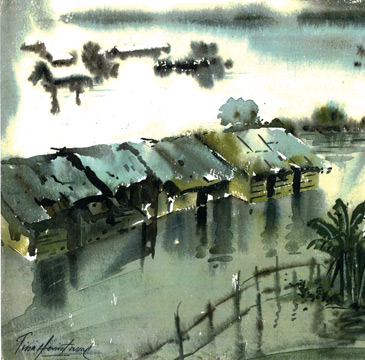How to portray water
by Tissa Hewavitarane
Water is one of the most popular painting subjects in watercolour.
Yet it isn't easy to get it right. One nice thing about water is that it
has rhythm in its movement and will generally repeat the sequence so you
can catch that fleeting movement again and again. Water, such as clouds,
is usually in motion so you must observe the way it looks at one
instance and catch that time on paper. One thing that dawned on me over
the years is just how little you need to do when you are painting a
river to make it look authentic. Whole areas can be just left as a flat
wash.
|

Floods |
Let's start with the river. Imagine your'e standing on the banks of
the Kelani River. It's a huge river with a smooth flow. In an around
you'll find boats in all shapes and sizes, people bathing and some
washing clothes. Their size in relation to their surroundings gives a
dramatic impression of the sheer scale and grandeur of the natural
world.
Always try to imagine the river as a soft mirror, reflecting
everything above it. Apart from when it is muddy and in flood a river
firstly reflects the colour of the sky, be it blue or stormy grey.
Secondly, it reflects the things that surround it such as trees, huts,
earth, and bridges all of course upside down.
Addict
I' am a complete addict when it comes to painting water. Whenever I
pass a river, stream or even a pond I have this irresistible urge to
stop and keep watching its movements.
Reflections in particular can be confusing and are often not well
understood by many watercolourists. Painting reflections in water takes
practice and close observation. Novice painters usually come unstuck
because first they do not understand the way reflections behave and
second they are too timid in their approach.
Strong contrasts
In the painting shown here, titled 'Floods' notice the reflections of
the huts, trees and the distant houses.
Even the calmest water is often disturbed by ripples and current that
break up and distort reflections, thus creating lovely wavering
patterns. Here the reflections of the huts and the trees are rendered
with dark limpid washes that give a lifelike impression of the smooth
gently undulating surface of the water.
I have emphasized the smooth glassiness of the water through the use
of strong contrasts of light and dark tone. Transparent glazes are
applied one on top of the other to build depth of tone and colour. Note
how strong and well defined they are. Observe its reflections and how
its colours reflected light acts on the objects around it and the water
coloured because of its dirt content either yellowish or brownish. The
dark reflections should be done as quickly and decisively as possible on
large stretches of water.
The surface is made very light where its further away and dark in the
foreground. This is because the horizon reflects the low, lighter part
of the sky, but close to the shore the water picks up the darker colour
from the sky above.
Surface
Also because we are looking down at it, the foreground water
transmits some of the colours of the bottom. With a large body of water
some parts of the surface are smooth while others are ruffled by wind.
Smooth water reflects the sky like a mirror but rough water picks up and
relays the light from any direction, either darker or lighter than the
sky depending on the prevailing conditions.
Water in a stream tumbles in some parts and flows in others. Watch
its movements very carefully for quite a long time and then try and
paint a generalisation of this movement. Brush strokes should follow the
action of the water. Don't put down every ripple because rushing water
looks much better when it's understated, and the absence of detail gives
an impression of rapid movement.Open sea and crashing surf are in
constant motion, but is recurring movement, because of the agitated
surface action, there is little of any reflection. Open sea water has no
colour of its own but reflects the colour of the sky overhead.
The rougher the water the darker the colour, but seas are usually
darker than the sky above. Generally, the sea is darker up close and
lighter as it recedes, unless sky conditions cause a variation.
Remember that the ocean is flat so you should keep your brush strokes
horizontal and not at various angles.
Waves nearby appear greenish, as do curling rollers. The white spray
splash, caps and surf can be masked out at first to preserve the white
spray, splash, caps and surf can be simply by left unpainted. What are
the main faults that crop up? There's no doubt at all about what is the
most command fault, it is over - elaboration to put in every ripple and
patch of light trying that momentarily catches your eye, most of which
more around with the breeze away. It's even worse with flowing water.
Details
One of the commonest faults in beginner's paintings is that they
contain too many irrelevant and distracting details that dilute or even
destroy the message of the picture. The secret of painting water is to
'edit out' all the superfluous details and go for the bigger masses of
tone and colour. You have probably heard the saying 'Less is more' and
nowhere does this apply more readily than in the painting of water.
Achieving the smooth, glassy look of water requires surprisingly
little effort, often after sweeping strokes with a broad brush on damp
paper are enough to convey the effect you want. You may leave much of
the paper bare and put in just a few telling ripples and reflections,
which are all that's needed to spell 'Water'. |

